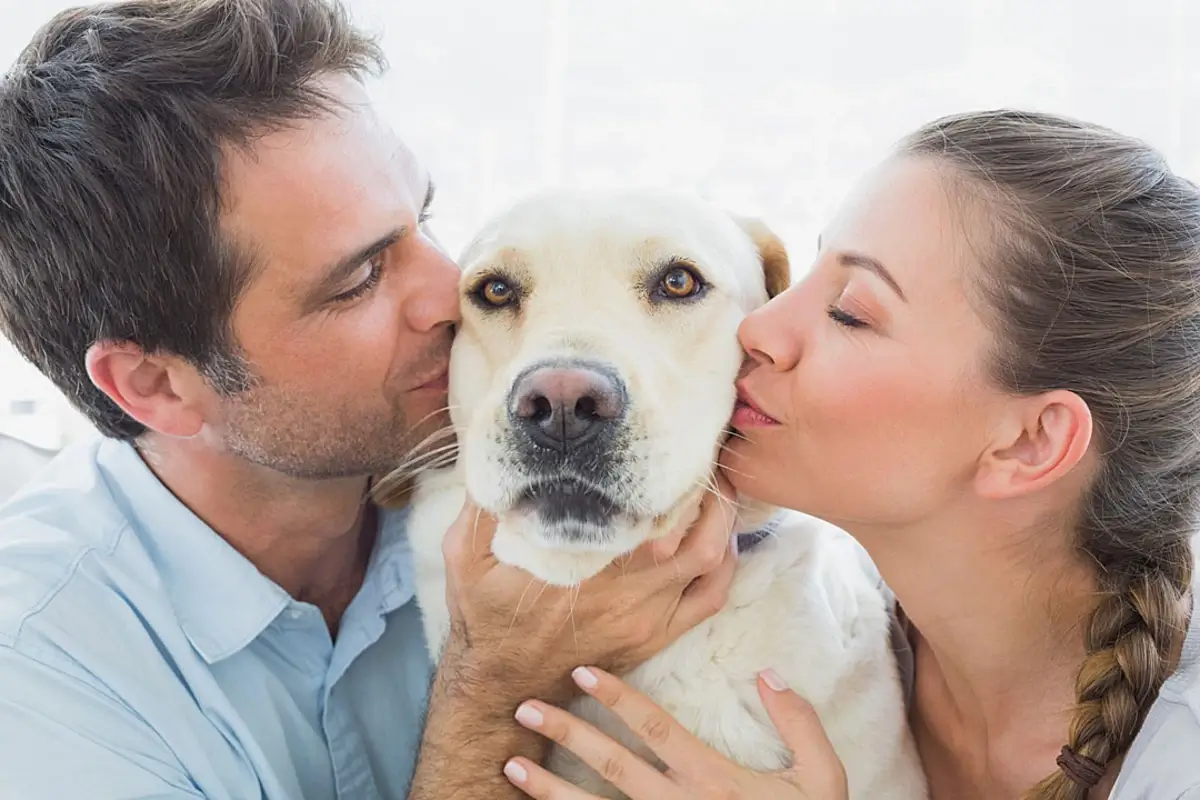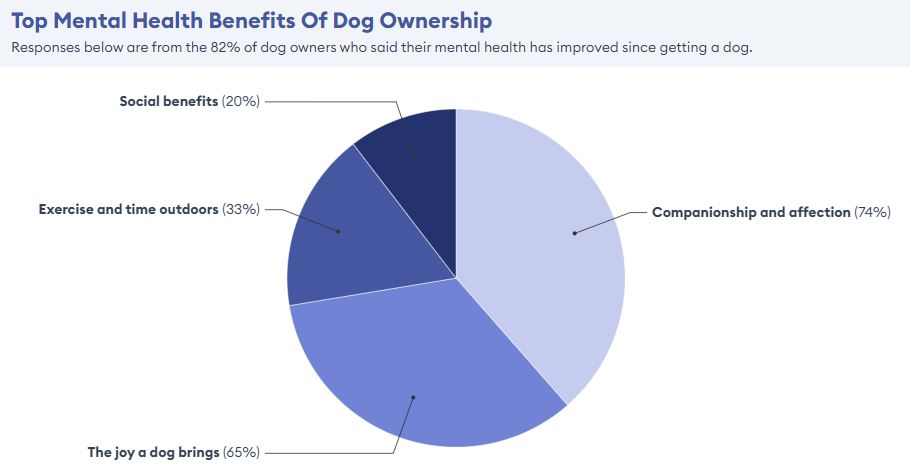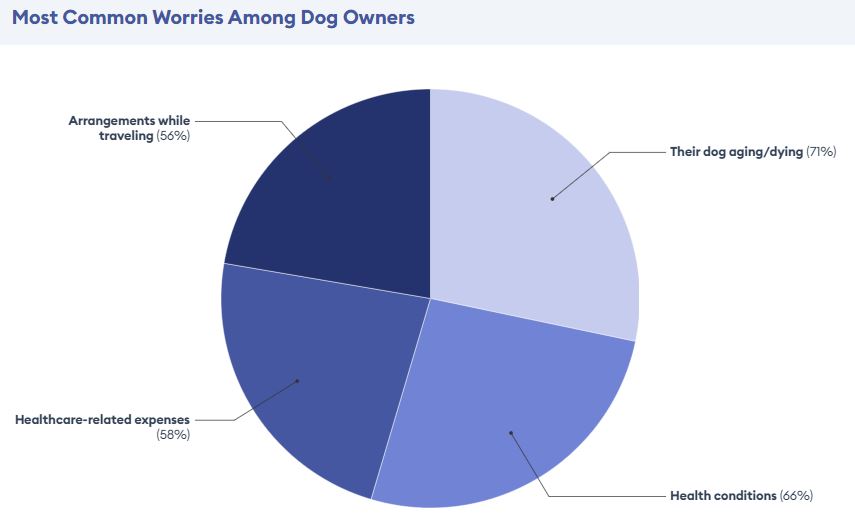Comprehensive Dog Facts and Statistics: Everything You Need to Know

Discover fascinating dog facts and statistics about why dogs are man’s best friend, their popularity in the U.S., and tips for choosing and caring for the perfect breed.
Dog Facts: Why They’re Truly Man’s Best Friend
Dogs, often called man’s best friend, provide lifelong companionship, unconditional love, and support. They can even enhance our physical and mental well-being.
The United States is home to 75 million dogs, making it the country with the most dogs in the world. Dogs are the most popular pets in America, followed closely by cats.
According to a recent survey by Forbes Advisor of 5,000 dog owners, 52% stated that the companionship and affection from their dogs were their favorite aspects of dog ownership.
With 200 dog breeds recognized by the American Kennel Club and millions of dogs in shelters, there’s a perfect match for everyone. When choosing a breed, it’s essential to consider your home environment, daily lifestyle, and reasons for getting a dog.
Prospective dog owners should also consider the costs of owning a dog, such as adoption fees, food, toys, and pet insurance, to ensure their furry friend has a healthy and happy life.
Ultimately, most dog owners agree that the love and companionship their dogs provide are truly priceless.
Fascinating Dog Facts

- The top two favorite dog breeds in America are the Australian Shepherd and the German Shepherd, according to a Forbes Advisor survey of 10,000 dog owners.
- Dogs have an estimated 300 million receptors in their noses, compared to humans, who have around 5 million.
- A dog’s nose is unique, similar to a human thumbprint.
- According to Guinness World Records, the world’s tallest dog is a Great Dane named Zeus, standing at 3 feet 5.18 inches tall, while the shortest dog is a Chihuahua named Pearl, at just 3.59 inches tall.
- Scientists believe dogs may recall parts of their day while dreaming, with puppies and older dogs dreaming more frequently than adult dogs.
- Boise, Idaho has the most dog parks per 100,000 residents.
Dog Ownership Facts

- U.S. Dog Ownership: 65.1 million U.S. households own at least one dog.
- Mental Health Benefits: A majority of dog owners (82%) say their mental health has improved due to having a dog, according to a 2024 Forbes Advisor survey of 5,000 dog owners.
- Generational Trends: Millennials represent the largest share of dog owners at 33%.
- Health Concerns: More than half of dog owners (66%) worry about their pet’s health.
- Financial Concerns: Roughly half of dog owners (58%) are concerned about affording their pet’s healthcare.
- Health Benefits: Owning a dog is associated with a 24% lower risk of all-cause mortality and a 31% lower risk of cardiovascular death.
- Community Benefits: Nearly all dog owners (91%) believe dog parks are beneficial to communities.
- Family Consideration: Nearly all dog owners (97%) consider their dogs family.
The History of Dogs
The bond between humans and dogs dates back as many as 15,000 years, making dogs the first species to be tamed by humans. Throughout history, dogs have been bred for various purposes, such as hunting, guarding, and herding. For instance, greyhounds were bred to chase prey, while large mastiff breeds served as guard dogs.
There is evidence suggesting that dogs were originally domesticated from wolves, although some theories propose they may have been domesticated from jackals. Scientists continue to explore the precise history and evolution of dogs.
Dog Ownership in the U.S

Pet ownership in the U.S. has increased significantly over the past 30 years. In 1988, 56% of U.S. households had a pet; by 2024, that number rose to 66%.
- Dog Ownership: 44% of U.S. households own a dog, while 30% own a cat.
- Top Reasons for Adopting a Pet:
- It was the right time to purchase/adopt/foster because they were spending more time at home (48%).
- Their family wanted a pet (47%).
- They were home alone and wanted pet companionship (25%).
According to a Forbes Advisor survey of 5,000 dog owners, the most common responses to “What is your favorite part about owning a dog?” were:
- The companionship and affection (52%).
- The joy they bring to my home (43%).
- The loyalty my dog has to me (41%).
- Annual Cost: The annual cost of owning a dog is approximately $2,500, which includes the cost of pet insurance.
- Most Expensive Recurring Expenses: According to a Forbes Advisor survey of 10,000 dog owners, the most expensive recurring expenses related to dog ownership are dog food (39%) and veterinary care (29%).
What’s Your Favorite Part Of Dog Ownership?
| Favorite Part of Dog Ownership | Percentage |
|---|---|
| Companionship and affection | 52% |
| The joy my dog brings me | 43% |
| The loyalty my dog has to me | 41% |
| The comfort my dog provides when I’m sad/stressed | 40% |
| The endless entertainment | 23% |
| Health benefits from exercising my dog | 14% |
| My dog has made me more social | 10% |
Dog Health Facts
Most pet owners view their dogs as more than just pets. While dogs provide love and affection, they also rely on their owners for companionship, physical and mental stimulation, and proper health care to live long and healthy lives.
Dental Disease in Dogs
- Prevalence: Periodontal disease, an infection and inflammation of the gums, is the most common disease affecting pet dogs. Over 80% of dogs over three years old suffer from periodontal disease.
- Symptoms: Common signs of dental disease include head shaking, pawing at the mouth, and jaw chattering. However, most dogs don’t show obvious signs of dental disease.
- Treatment: While some dog food manufacturers include dental health considerations in their recipes, professional removal of tartar under anesthesia is typically required once it has formed.
- Prevention: All dogs should have an annual oral exam as part of their yearly health checkups with their veterinarian.
- Cost of Dental Cleanings: Dental cleanings for dogs can cost between $170 to $350 if performed by a general practitioner veterinarian, or up to $4,000 if done by a board-certified veterinary dentist.
Dog Dental Care and Taste Sensation

Dental Care
- Brushing Frequency: Pet owners should start brushing their dog’s teeth around six months old and aim for three to four times a week.
- Brushing Habits: According to a Forbes Advisor survey, 55.6% of dog owners brush their dog’s teeth at least once a month, while 14.4% never do.
- Toothpaste Caution: Never use human toothpaste on dogs as some ingredients can be harmful.
Can Dogs Taste?
- Taste Buds: Dogs have around 1,700 taste buds, significantly fewer than humans’ 9,000.
- Taste Classifications: Like humans, dogs can taste sweet, sour, salty, and bitter flavors.
- Water Sensitivity: Dogs have taste buds specifically for water at the tips of their tongues, suggesting they can perceive water more distinctly than humans.
- Enhanced Sensitivity: After consuming salty or sugary foods, a dog’s water taste buds become more sensitive, likely aiding hydration in the wild.
Sense of Smell
- Olfactory Receptors: Dogs possess about 300 million olfactory receptors in their noses, far surpassing humans’ 5 million.
- Food Preferences: Due to their keen sense of smell, dogs are more attracted to foods with stronger scents.
- Picky Eaters: Owners of picky-eating dogs may find success with aromatic foods like canned food, which is more enticing due to its strong smell.
- Legal Use: Bloodhounds’ exceptional sense of smell is so reliable that it can serve as evidence in legal proceedings.
Understanding these aspects of dog dental care, taste sensation, and olfactory abilities can help pet owners better care for their dogs’ health and dietary preferences.
How Dogs Regulate Heat

Sweating Mechanism
- Paw Pads: Dogs sweat through their paw pads via merocrine glands, which activate when they are overheated.
- Primary Cooling Method: Despite having sweat glands on their paws, dogs primarily regulate their body temperature through panting.
- Panting Process: Panting helps dogs cool down as moisture from their tongue, nose, and lungs evaporates during the process.
Fur Functionality
- Seasonal Adaptation: A dog’s fur serves as an insulator, keeping them cool in summer and warm in winter.
- Insulating Layer: Pet owners should avoid shaving double-coated dogs as it removes their natural insulation, making them vulnerable to heatstroke.
Heatstroke in Dogs
- Severity: Heatstroke can be fatal for dogs and is characterized by symptoms such as frantic panting, dehydration, hot body temperature, excessive drooling, vomiting, and bright red gums.
- Common Causes:
- 75% of cases result from over-exercising or exercising on hot days.
- 13% occur when dogs cannot acclimate to hot weather, such as during heatwaves or sudden location changes.
- 5% happen when dogs are left in hot vehicles.
- 3% occur in hot buildings.
- Mortality Rate: Approximately one in seven dogs treated for heatstroke will not survive.
- At-Risk Breeds: Breeds like Pugs, Boxers, Bulldogs, Boston Terriers, and French Bulldogs are more susceptible to heatstroke, especially those that are obese or have dark coats.
Understanding how dogs regulate heat and the risks associated with heatstroke can help pet owners take proactive measures to keep their dogs safe and healthy, especially during hot weather conditions.
Keeping Your Dog Cool in the Summer

Exercise and Timing
- Choose Cooler Times: Exercise your dog in the morning or evening to avoid the heat of midday.
- Hydration: Always carry water for your dog to prevent dehydration.
- Take Breaks: Take frequent breaks during outdoor activities to allow your dog to rest and cool down.
Safety Measures
- Never Leave in Car: Never leave your dog alone in a car, as temperatures can rise by 20°F in just 10 minutes.
- Signs of Heatstroke: Watch for signs of heatstroke such as heavy breathing, extreme thirst, weakness, and fatigue.
- Provide Shade: Ensure your dog has access to plenty of shade throughout the day.
- Cooling Aids: Consider using a cooling mat or vest for your dog, or dabbing rubbing alcohol behind their ears, paws, and belly to help draw out heat.
Vision Capabilities of Dogs
- Color Perception: Dogs are not colorblind; they can see shades and combinations of yellow and blue.
- Depth Perception: While dogs lack human-like depth perception, they have excellent peripheral vision due to their side-set eyes.
The Health Benefits of Having a Dog

Many pet owners experience significant mental and physical health benefits from having a dog at home:
- Mental Health Improvements: 82% of dog owners report improved mental health, with companionship, joy, increased exercise, and social interaction cited as major benefits.
- Survey Insights: In a Forbes Advisor survey:
- 82% of dog owners noted improved mental health due to their dogs.
- Top benefits include companionship (74%), joy (65%), increased exercise (33%), and enhanced sociability (20%).
- Challenges: A small percentage (2%) reported declines in mental health due to issues like disrupted routines, financial strain, or damage to possessions.
Understanding these tips and insights can help ensure your dog stays safe, healthy, and happy during the summer months while enjoying the benefits of canine companionship.
Health Benefits of Dog Ownership

Heart Health and Mortality
- Lower Risk of Mortality: Dog ownership is associated with a 24% lower risk of all-cause mortality, based on studies spanning from 1950 to 2019.
- Cardiovascular Benefits: Dog owners experience a 31% reduced risk of cardiovascular death.
- Post-Heart Event Benefits: For individuals with prior coronary events, living with a dog significantly reduces the risk of all-cause mortality.
Blood Pressure and Stress Reduction
- Lower Blood Pressure: Pet ownership, particularly dogs, leads to lower blood pressure through increased oxytocin release and reduced cortisol levels.
- Stress Reduction: Interaction with dogs can reduce cortisol levels in just 10 minutes, contributing to overall stress reduction.
- Oxytocin Release: Owning a dog increases oxytocin levels, known as the “feel-good” hormone that fosters bonding, similar to the bond between mothers and their children.
Mental Health Benefits
- Positive Impact: Dog and cat owners are more likely to report positive impacts on their mental health (86%) compared to owners of other pets (62%).
- Common Concerns: Despite the benefits, pet owners commonly worry about their pet aging or passing away (71%), their pet’s health (66%), travel arrangements (56%), and affording their pet’s healthcare (58%).
Understanding these health benefits and considerations can help pet owners appreciate the positive impact dogs can have on both physical and mental well-being, while also preparing for the responsibilities and potential worries associated with pet ownership.
Dogs and Their Impact on Owners

Medical and Mental Health Benefits
- PTSD Relief: 84% of PTSD patients paired with service dogs reported significant symptom reduction, with 40% reducing medication reliance.
- Depression Mitigation: Individuals with HIV who own dogs are three times less likely to suffer from depression compared to non-dog owners.
- Senior Depression: Dogs have been shown to reduce depression in seniors, sometimes by as much as 50%.
Exercise and Physical Health
- Exercise Frequency: Dog owners walk their dogs nearly 300 minutes per week, double the amount of non-dog owners.
- Health Benefits: 14% of dog owners value the health benefits of exercising with their dogs, with 33% citing improved mental health due to increased outdoor activity.
- Physical Activity: Dog owners are 34% more likely to meet federal physical activity guidelines of 150 minutes per week compared to non-dog owners.
- Activity Comparison: Dog owners are twice as likely as cat owners to find their pets help them stay physically active.
Sleep Considerations
- Sleep Issues: Dog owners are more prone to sleep disorders such as sleep apnea and feeling unrested compared to non-dog owners, often due to sleep disruptions caused by their pets.
Dog Sleep Patterns and Behavior

Sleep Patterns
- Sleep Duration: Dogs spend about half of their day sleeping, with puppies needing up to 18 to 20 hours of sleep.
- Bed Sharing: 45% of dog owners allow their pets to sleep in their beds.
Dreaming and Cognitive Abilities
- Dreaming Similarities: Dogs dream similarly to humans, recalling parts of their day during dreams.
- Dream Duration: Dogs’ dreams last 1 to 10 minutes, occurring every 10 to 90 minutes depending on their size.
- Dream Content: Dogs may dream about familiar experiences such as playing fetch or enjoying treats, with smaller dogs dreaming more frequently but for shorter durations.
- Nightmare Prevention: It’s advised not to wake dogs during nightmares to prevent potential aggression.
Vocabulary and Intelligence
- Word Recognition: Dogs can learn over 100 words on average, with highly intelligent breeds like Border Collies and German Shepherds capable of understanding up to 1,000 words.
- Training Tips: Enhancing a dog’s vocabulary involves removing distractions, consistent repetition, and rewarding correct responses.
Importance of Dog Parks

Community Benefits
- Public Opinion: 90% of Americans view dog parks as beneficial to communities.
- Top Benefits: Dog parks offer safe spaces for dogs to roam (60%), facilitate socialization (39%), and encourage owner-dog activity (36%).
Location Insights
- Top Cities for Dog Parks: Boise, Idaho leads with 7.6 dog parks per 100,000 residents, followed by Portland, Oregon and San Francisco.
- Lowest Dog Park Availability: Cleveland, Ohio has the fewest dog parks per capita among major U.S. cities.
Cities with the Most Dog Parks per 100,000 Residents
| City | Dog Parks per 100,000 Residents |
|---|---|
| Boise, Idaho | 7.6 |
| Portland, Oregon | 6 |
| San Francisco, CA | 5.2 |
| Henderson, Nevada | 5.1 |
| Sacramento, CA | 4.4 |
| Las Vegas, NV | 3.8 |
| Chula Vista, CA | 2.9 |
City with the Least Dog Parks per 100,000 Residents
| City | Dog Parks per 100,000 Residents |
|---|---|
| Cleveland, Ohio | 0.3 |
These tables summarize the cities with the most and least dog parks per 100,000 residents based on the provided information.
By understanding these aspects of dog ownership, owners can better appreciate the multifaceted benefits and considerations associated with their canine companions, from health and exercise to community interaction and sleep patterns.
Here are 10 FAQ about strange facts about dogs:
- Do dogs have a sense of time?
Dogs have a unique sense of time and can often predict regular events like meal times or walks based on routines. - Can dogs see in the dark?
While not as well as cats, dogs have good night vision thanks to their reflective layer behind the retina called the tapetum lucidum. - Why do dogs circle before lying down?
Circling before lying down is an instinctive behavior inherited from their wild ancestors to flatten grass or create a comfortable spot. - Do dogs have a favorite color?
Dogs see predominantly in shades of yellow and blue, but they don’t have a preference for specific colors like humans do. - Can dogs detect illness in humans?
Dogs have been known to detect changes in their owners’ body chemistry that can indicate illness, such as cancer or impending seizures. - Why do dogs tilt their heads when we talk?
Dogs tilt their heads to adjust their ears, which helps them better locate the source of a sound or express curiosity. - Do dogs sweat?
Dogs primarily regulate their body temperature through panting rather than sweating, although they do have sweat glands in their paw pads. - Can dogs understand human emotions?
Dogs are adept at reading human facial expressions and body language, which helps them gauge our emotions and respond accordingly. - Why do dogs eat grass?
Eating grass may help dogs alleviate digestive discomfort or supplement their diet with fiber, although not all dogs do it regularly. - Do dogs have a sense of fairness?
Studies suggest that dogs exhibit behaviors that indicate a sense of fairness, such as becoming upset when they perceive unequal treatment.
These FAQs cover some of the intriguing and lesser-known behaviors and abilities of our canine companions.




One Comment